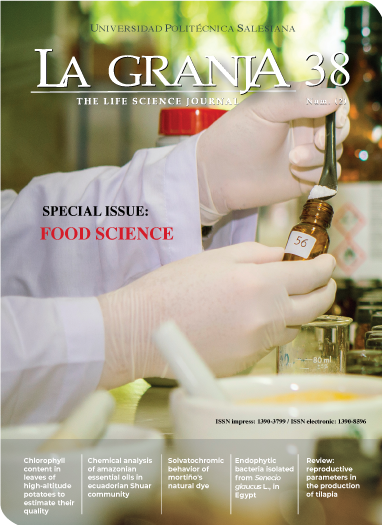Evaluation of digital land and geopotential models in Ecuador
Main Article Content
Abstract
Article Details

This work is licensed under a Creative Commons Attribution-NonCommercial-ShareAlike 4.0 International License.
Universidad Politécnica Salesiana of Ecuador preserves the copyrights of the published works and will favor the reuse of the works. The works are published in the electronic edition of the journal under a Creative Commons Attribution/Noncommercial-No Derivative Works 3.0 Ecuador license: works can be copied, used, disseminated, transmitted and publicly displayed.
The undersigned author partially transfers the copyrights of this work to Universidad Politécnica Salesiana of Ecuador for the printed edition.
References
Abbondati, F. y col. (2020). «Rural Road reverse engineering using bim: an italian case study». En: Environmental Engineering. Proceedings of the International Conference on Environmental Engineering. Ed. por Department of Construction Economics Property Vilnius Gediminas Technical University. Vol. 11, págs. 1-7.
Alaska Satellite Facility (2021). ALOS PALSAR – Radiometric Terrain Correction.
Anselin, L. (1995). «Local indicators of spatial association-LISA». En: Geographical analysis 27.2, 93-115. Online: https://n9.cl/buf79h.
Cañizares, E. (2015). «Análisis del Sistema de Alturas para la Red de Control Básico Vertical del Ecuador». Tesis de maestría. Universidad de las Fuerzas Armadas ESPE.
Drewes, H. y col. (2002). «Scientific foundations of the SIRGAS vertical reference system». En: Vertical Reference Systems: IAG Symposium Cartagena, Colombia, February 20-23, 2001, págs. 297-301.
ESRI (2020). Cómo funciona Análisis de clúster y de valor atípico (I Anselin local de Moran).
Falorni, G. y col. (2005). «Analysis and characterization of the vertical accuracy of digital elevation models from the Shuttle Radar Topography Mission». En: Journal of Geophysical Research: Earth Surface 110.F2, Online: https://n9.cl/xtg90.
Federal Geographic Data Committee (1998). Geospatial Positioning Accuracy Standards Part 3: National Standard for Spatial Data Accuracy. U.S. Geological Survey.
Gil-Docampo, M. y col. (2023). 3D geometric survey of cultural heritage by UAV in inaccessible coastal or shallow aquatic environments. Inf. téc. Archaeological Prospection.
Hirt, C., M. Filmer y W. Featherstone (2010). «Comparison and validation of the recent freely available ASTER-GDEM ver1, SRTM ver4. 1 and GEODATA DEM-9S ver3 digital elevation models over Australia». En: Australian Journal of Earth Sciences 57.3, 337-347. Online: https://n9.cl/2l9cp.
Kotsakis, C. y col. (2010). «Gravity, Geoid and Earth Observation». En: International Association of Geodesy Symposia. Cap. Evaluation of EGM08 Using GPS and Leveling Heights in Greece, págs. 481-488.
Lemoine, F. y col. (1998). The development of the joint NASA GSFC and the National Imagery and Mapping Agency (NIMA) geopotential model EGM96. Inf. téc. National Aeronautics y Space Administration, Greenbelt.
Li, Z., C. Zhu y C. Gold (2004). Digital terrain modeling: principles and methodology. CRC press.
Luna, M. P. y col. (2017). «Methodological approach for the estimation of a new velocity model for continental Ecuador». En: Open Geosciences 9.1, págs. 719-734.
Mancero, H. y col. (2015). «Evaluación de Modelos Digitales de Elevación obtenidos por diferentes sensores remotos». En: Congreso de Ciencia y Tecnología ESPE, págs. 107-111.
Martínez, E. y A. Bethencourt (2012). «Comparación de la precisión de los Modelos Geopotenciales EGM96 y EGM08 en la zona del Caribe». En: X Topcart 2012. I Congreso Iberoamericano de Geomática y Ciencias de la Tierra.
McClean, F., R. Dawson y C. Kilsby (2020). «Implications of using global digital elevation models for flood risk analysis in cities». En: Water Resources Research 56.10, e2020WR028241.
Orejuela, I.P. y col. (2021). «Geoid undulation modeling through the Cokriging method-A case study of Guayaquil, Ecuador». En: Geodesy and Geodynamics 12.5, págs. 356-367.
Pavlis, N. y col. (2012). «The development and evaluation of the Earth Gravitational Model 2008 (EGM2008) ». En: Journal of geophysical research: solid earth 117. Online: https://n9.cl/f0ntr7.
Rabus, B. y col. (2003). «The shuttle radar topography mission-a new class of digital elevation models acquired by spaceborne radar». En: ISPRS journal of photogrammetry and remote sensing 57.4, 241-262. Online: https://n9.cl/hkgft.
Sánchez, L. (2015). «IAG Resolutions Adopted by the IAG Council at the XXVIth IUGG General Assembly». En: XXVIth IUGG General Assembly. Praga: IAG.
Seeber, G. (1993). Satellite Geodesy: foundations, methods, and applications. Walter de Gruyter GmbH y Co. KG.
Sinde-González, I. y col. (2021). «Biomass estimation of pasture plots with multitemporal UAVbased photogrammetric surveys». En: International Journal of Applied Earth Observation and Geoinformation 101, pág. 102355.
Tachikawa, T. y col. (2011). ASTER global digital elevation model version 2-summary of validation results. Inf. téc. NASA.
Tierra, A. (2009). «Evaluación del EGM08 y EGM96 en el Ecuador a partir de datos de GPS y nivelación geométrica». En: Revista Geoespacial 6, 72-80. Online: https://n9.cl/udlci.
Tierra, A. y V. Acurio (2014). «Modelo Neuronal Geoidal Geométrico del Ecuador Continental - MNGGE14». En: Simposio SIRGAS 2014.
Villasenín, S. Peña, M. Gil-Docampo y J. Ortiz-Sanz (2017). «3-D modeling of historic façades using SFM photogrammetry metric documentation of different building types of a historic center». En: International Journal of Architectural Heritage 11.6, págs. 871-890.
Zafar, S. y A. Zaidi (2019). «Impact of urbanization on basin hydrology: a case study of the Malir Basin, Karachi, Pakistan». En: Regional Environmental Change 19, págs. 1815-1827.

